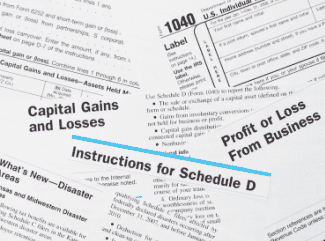As The Tax Bill Is Finalized, Landlords Have Much At Stake

But don’t let the smiles fool you…the GOP’s work is not done. You see, the Senate’s passage of HR 1 by a 51-49 margin last Friday did not mark the end of the process; rather, the Senate bill must now be merged together with a companion bill that was crafted by and passed in the House several weeks earlier. The two chambers will soon break bread and try to agree on a final bill, which can then be sent to the President, who will formally tweet it into law.
While the GOP’s vision of tax reform is largely uniform between the House and Senate bills, there are some significant differences that will need to be ironed out. Here are a just a few of the items that will have to be reconciled:
| House | Senate | |
| Individual Tax Rates | 4 brackets, top rate of 39.6% | 7 brackets, top rate of 38.5% |
| Child Tax Credit | $1,600 | $2,000 |
| Medical Expense Deduction | Eliminated | Preserved |
| Alimony Deduction | Eliminated | Preserved |
| Education Incentives | Eliminated | Preserved |
| Alternative Minimum Tax | Eliminated | Preserved, but with larger exemption |
| Length of all Individual Changes | Permanent | Expire at the end of 2025 |
| Individual Insurance Mandate | Preserved | Eliminated |
| Estate Tax | Repealed in 2023 | Preserved, but with a doubled exemption |
| Corporate Tax Rate | 20% immediately | 20% in 2019 |
Perhaps the most dramatic disparity, however, can be found in the way the respective bills treat the income of owners of S corporations and partnerships, so-called “flow through entities.”
Taxation of Flow-Through Entities, In General
As a general rule, S corporations and partnerships (think: an LLC) do not pay tax at the business level. Instead, the income of the business is chopped up and allocated among its owners, who report the income and pay the corresponding tax on their individual returns at ordinary tax rates, which under current law rise as high as 39.6%.
To the contrary, so-called C corporations do pay tax at the business level, at a top rate of 35% under current law. C corporations are, quite famously, subject to “double taxation,” because after the corporation pays tax on its income when it’s earned, the shareholders will pay tax on the same income a second time when it is distributed to the shareholders as a dividend (at at top rate of 23.8%).
The foundation of both the House and Senate tax proposals has been to reduce the corporate tax from 35% to 20%. But you can’t do that without changing the treatment of pass-through businesses; after all, if you reduce the corporate rate to 20% but leave the income of S corporations and partnerships subject to tax at a top rate of 39.6% (or 38.5% in the case of the Senate bill), then the advantage previously afforded to flow-through entities relative to C corporations would be largely eliminated.
As a result, both the House and Senate bills attempt to confer a benefit on the owners of S corporations and partnerships in hopes of preserving the advantage they enjoy over C corporations. The two proposals address the issue in dramatically different ways, and based on an initial reading of the proposed legislation, a certain class of taxpayers could have a LOT at stake as Congress tried to determine which plan to adopt.
Who should be concerned? Owners of rental property who produce income, because the two proposals differ greatly in the way they treat so-called “passive income.” But before we can understand the difference, we’ve got to get a handle on who would be impacted.
So what is passive income? To answer the question, we’ve got to go back in time 31 years…
Pre-1986: Tax Shelters For Everyone!
Prior to the Tax Reform Act of 1986, tax shelters were readily available to anyone with disposable income and the patience to be a landlord. Consider the following example:
In 1985, A, a doctor, expects to earn wages of $300,000. On January 1, 1985, in hopes of sheltering his wage income, A purchases a home as a rental property and rents the home at fair market value. The rental is low-maintenance, and A is rarely required to visit the property other than to collect the occasional check. By virtue of large depreciation deductions, the rental generates a sizeable net loss, which A uses to partially offset his wage income, significantly lowering his tax bill. It is a win-win situation for A; he generates losses largely through non-cash depreciation deductions, while all the while, the rental home is appreciating in value.
Post-1986: No Rental Losses for Anyone!
The Tax Reform Act of 1986 put an end to such shelters, however, with the enactment of Section 469. Effective for tax years beginning after December 31, 1986, a taxpayer’s loss from a “passive activity” can only be used to offset income from a “passive activity.” A passive activity is defined in part as:
- Any trade or business of the taxpayer in which the taxpayer does not “materially participate,” and
- Any rental activity of the taxpayer regardless of the taxpayer’s level of participation.
As a result of the treatment of all rental activities as passive activities, the doctor’s loss in the previous example from his rental home would be treated as a passive loss. And because the doctor’s wages are not treated as passive income, the rental loss could no longer be used to offset the doctor’s wage income.
Fast Forward to 2018
As the example involving the doctor illustrates, historically, we’ve been primarily concerned with whether an activity is passive when the activity produces losses, because those passive losses can only be used to offset passive income. Come January 1, 2018, however, taxpayers with passive income — which as explained above, generally includes ALL RENTAL INCOME — could suddenly have a lot at stake, depending on whether the House or Senate bill governing pass-through income triumphs in reconciliation.
To understand the impact, let’s walk through a simply case study:
A owns 11 commercial properties together with another party, B. Each property is held in a separate LLC. In addition, A and B have formed a management company to oversee the 11 rental properties. Assume the following:
- A works 700 hours during the year, all in the management company. As a result, he will not qualify as a “real estate professional”, and all rental income will thus be passive.
- The 11 commercial properties produce a total of $2 million of annual rental income to A. The LLCs the properties are housed in pay no wages or guaranteed payments.
- The management company employs three people — a controller, an accountant, and an administrative assistant — who are paid annual wages totaling $200,000.
- The management company breaks even each year, recognizing neither taxable income nor loss.
Treatment of A under the House Bill
The House version of HR 1 attempts to provide a benefit to the owners of S corporations and partnerships by providing that all “qualified business income” is eligible for a preferential top rate of 25%. That way, even with the C corporation rate coming down to 20%, owners of flow-through entities would retain their tax advantage by virtue of a top rate of 25%.
While there are no shortage of ways to fail to qualify for that preferential rate, the proposed law makes one thing very clear: “qualified business income” includes all passive income. As a result, the $2 million of income A receives from his 11 commercial properties will be taxed at a top rate of 25%, so that A will pay a total tax bill of $500,000 (ignoring the lower graduated rates and the 3.8% net investment income tax that applies to all passive income above a threshold). Not a bad deal, when you consider that under current law, the income would be taxed at a top rate of 39.6% and produce a tax bill of nearly $800,000. Thus, if the House bill becomes law, A would save nearly $300,000 in tax, relative to current law.
Treatment of A under the Senate Bill
Things would look drastically different for A, however, should the Senate’s provision governing pass-through entities win out. The Senate proposal eschews a top tax rate in favor of a deduction; the owner of the pass-through entity would be entitled to deduct 23% of the income allocated to him or her from the business.
But there’s a catch. OK, to be fair, there’s many a catch under these rules, but the one we’re focused on right now is this: the owner of a pass-through business may only claim the 23% deduction up to a limit, equal to 50% of the W-2 wages (or partnership guaranteed payments) paid out by the business.
[Two notes on this deduction: the wage limitation does not apply if the business owner’s income is less than $250,000 (if single, $500,000 if married). In addition, owners of “personal service businesses” — i.e., accounting, law and consulting firms, among others — are not eligible for the 23% deduction unless income of the owner is less than $250,000 (if single, $500,000 if married.)]The purpose of the limitation is to attempt to prevent an owner of a business from forgoing compensation for services in favor of additional flow-through income that will be eligible for the new deduction. Let’s leave A for a moment and consider this scenario:
Assume X is the sole owner and employee of an S corporation. He provides significant services. The S corporation earns $1,000,000 annually. If X withdraws the $1,000,000 as a salary to compensate him for his services, the wages are taxed at ordinary rates as high as 38.5% under the Senate proposal, generating a tax of $385,000.
Alternatively, to take advantage of the deduction offered by the Senate proposal, X could simply leave the $1,00,000 of income in the S corporation, to be taxed to X as “flow-through income.” Barring a safeguard measure, X would be entitled to a 23% deduction against the income, reducing his taxable income to $770,000 and his tax bill from $385,000 to $296,450, a significant savings.
The Senate proposal prevents such an abuse, however, by limiting X’s deduction to 50% of the wages paid by the S corporation. In the second scenario, because X takes no wages in an attempt to abuse the system, X runs afoul of the “50% of W-2 wages” limitation, and the Senate bill allows for no deduction. Thus, X’s flow-through income would remain $1,000,000 and his tax bill $385,000, just as it was when he withdrew the full $1,000,000 as wages.
With that understood, let’s go back to A, our well-to-do landlord. He has total rental income of $2,000,000, but his entities combine to pay out only $200,000 in W-2 wages; thus, the limitation looms large. Even worse, it appears the Senate bill looks at the wage limit on a business-by-business basis; as a result, because A’s only business that pays wages is the management company — which has no net income — he would not be entitled to a deduction against that income. He would also not be entitled to a 23% deduction against the $2,000,000 of rental income, because those separate LLCs pay neither wages nor guaranteed payments.
In summary, it appears that under the Senate bill, A would recognize $2,000,000 of passive rental income with no offsetting deduction, with the income taxed at the Senate’s top rate of 38.5%, resulting in a tax bill of $770,000. If you’re scoring at home — or even if you’re all alone — that would represent an increase of $270,000 over the’s $500,000 bill A had under the House version of HR 1.
Putting it all Together
Could this be an accident? Or does the House bill purposefully cater to owners of rental properties by offering a no-questions-asked top rate of 25%, with the Senate bill doing just the opposite, making it nearly impossible for a rental owner to get the benefit of the 23% deduction by virtue of the fact that rental properties rarely pay wages or guaranteed payments?
The answer? Who knows. This process has been so rushed on both sides, it is completely reasonable to suspect that this is simply an oversight, and the two chambers will give the issue the careful consideration it deserves in the weeks to come. And if the President has anything to say about it — well, let’s just remember that he stands to save a fortune should the House bill win out, as it would give him a 25% rate on all of his passive rental income.
The treatment of a passive rental property owners is not the only hole that needs to be plugged in the treatment of flow-through entities, however. There is also potential for abuse under the Senate bill in the opposite scenario: an active owner of an S corporations or partnership that pays significant wages to non-owner employees.
Follow along:
Jerry X is the sole owner of America’s Team, a once-proud NFL franchise that has slowly devolved into a glorified three-ring circus. Shoot, that’s too obvious…let’s call him Mr. Jones, instead. Yeah, that’ll do it…
Anyway, Mr. Jones is a VERY hands on owner. The team is housed in an S corporation, and generates $20,000,000 of income for Jones annually, after deducting $60,000,000 in salaries to players and team personnel. Traditionally, Jones has paid himself a salary of $10,000,000 and withdrawn the remaining $10,000,000 as a distribution.
Assume the Senate bill and its 23% deduction triumphs and becomes law. If Mr. Jones does nothing different in 2018, his $10,000,000 salary will be taxed at ordinary rates of 38.5%, resulting in a tax liability of $3,850,000. Then, Mr. Jones will be entitled to a deduction of 23% against the $10,000,000 of flow-through income, leaving him with $7,700,000 of income and a tax bill of nearly $3,000,000 ($7,700,000 * 38.5%). Thus, total tax at the individual level would be $6,850,000. The deduction is allowed in full because the amount ($2,300,000) does not come close to hitting the limit of 50% of wages paid by the business ($30,000,000, or 50% of $60,000,000).
But what prevents Mr. Jones from saving himself a bundle of tax by skipping the salary in 2018 and taking the full $20,000,000 out as earnings and distributions? He would still be entitled to a deduction of 23% against the $20,000,000 of income — or $4,600,000– because again, that amount would not run afoul of the “50% of W-2 wages” limitation.
As a result, by virtue of the large salaries Mr. Jones pays to non-owners, he could convert salary taxed at ordinary rates into flow-through income eligible for a 23% deduction.
This column, of course, is just scratching the surface in identifying problems with this last-minute legislation. It’s been said before, but when you try to construct tax reform that is three decades in the making in the span of just four weeks, there will be some confusion. Some drafting orders. Some big, gaping loopholes just begging to be exploited.
Source: forbes.com















 Accessibility
Accessibility